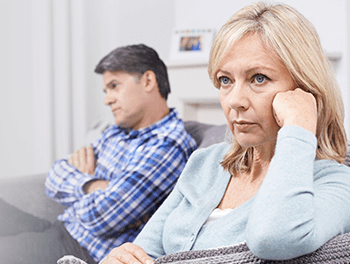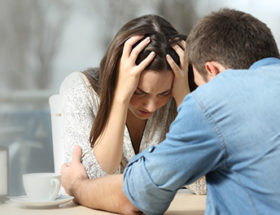Ever heard of breadcrumbing or cushioning before? We explore some of the latest dating words and question what's actually going on.
What does it mean when we talk about codependent relationships? Sure, it’s become a bit of a buzzword over the last few years, but what does it actually feel like to be caught in the cyclicality of codependency? EliteSingles Magazine reached out to renowned psychotherapist Darlene Lancer to peel apart this complex topic and journey to the epicentre of the matter.
What is codependency?
Most experts agree that the term codependency first emerged towards the end of the 20th century. It was first utilised by mental health professionals to label the dynamic between alcoholic husbands and their wives, a relationship that’s often regarded as the hallmark of codependency. The two roles central to this kind of partfrom-single-to-couple/nership are patently clear; the husband is dependent on his wife’s unswerving care, which effectively enables his addiction.
Since then, codependency has morphed it something of a catchall term. Nowadays it encompasses a host of issues that arise when a relationship is imbalanced. However, like the above example, there’s often a disjuncture at play where one person is overly reliant on another’s support; this usually presents when two people are overly dependent on each other for emotional validation and fulfilment.
This expansive definition has without doubt instilled a bit more complexity into the matter. Keen to understand what’s going on, we spoke to Darlene Lancer, one of America’s leading experts when it comes to codependency. Based out of Santa Monica, California, Lancer has written extensively on the topic over the last few decades and has a corpus of books to her name. One of her most popular titles – Codependency for Dummies – is widely regarded as the most comprehensive working on said subject.
Upon penning her magnum opus, Lancer noticed the patients she’d been treating were all exhibiting similar issues to one another. “You can reframe it as individuation,” she says, referencing a process of building a seperate psychological self whereby a person’s perceptions, thoughts, feelings, and beliefs are their own, not those of their family. “My clients weren’t starting from a healthy place, they had traumas in both their childhood and adult relationships,” she adds.
Where does it all begin?
There’s consensus that a person is more likely to exhibit codependent behaviours if their familial background was dysfunctional. When asked how and when these habits are most likely to originate, Lancer is forthright. “It’s trans-generational and gets passed down through modelling and interactions with parents,” Lancer says, “generally, parents don’t respect their children’s boundaries so that by adulthood their children have dysfunctional boundaries.”
It’s important to note that codependency can stem from a multitude of different family contexts, there’s no one typical type. There’s evidence to suggest that people who grow up in unstable families where issues like addiction, abuse, traumatic experiences and neglect are more likely to develop codependent characteristics.
Conversely, some people prone to codependency may have matured in a perfectly ‘functional’ familial environment. Being brought up in a hothouse is also hazardous as it puts unrealistic pressure on a person. Demands are often stringent, bars are set at unattainable levels and attentiveness towards emotional needs wanes in the pursuit of developing a sturdy sense of self.
How to spot a codependent relationship
So how do you tell if you or someone you know is in a codependent relationship? Fortunately, there are some obvious red flags. As Lancer points out, “people with low self-esteem and who’ve experienced trauma or abuse in childhood” are more prone to codependency. She also says relationships where “addiction or mental illness is present” have a tendency to be codependent.
Lancer lists a range of behaviours that may be prominent in a codependent relationship. “Dysfunctional communication, intimacy issues, caretaking and keeping secrets,” are all common, says the American psychotherapist. She also mentions that issues with personal boundaries and the denial of needs may be present.
A lack of self-sufficiency and autonomy are often prominent in a codependent relationship. This state of powerlessness may influence one or both parties in the partnership. Needing to feel needed is another prominent feature, and one that corresponds with a strong desire to help; going above and beyond makes someone feel wanted. This is also bound to a need to control both people and situations so as to give them a sense of self-worth and often stave off feelings of shame and anxiety.
Interestingly, Lancer suggests that someone who’s prone to codependency has a higher chance of entering into a relationship with a narcissist. “Narcissists are codependent, too,” she says, “they often pair with people who sacrifice their needs and idealise them.” This poisonous bond is the perfect pedestal; the codependent is looking for an enabler, and the narcissist is searching for constant praise. These roles coexist perfectly, one reinforcing the other, and vice versa.
Lancer stresses that codependency is synonymous with feelings of shame, and if the cycle isn’t broken it can be further damage a person’s self-esteem. “It worsens over time, destructive relationships are damaging and create more traumas to overcome,” she says.
READ MORE: 10 Brilliant Signs You’re in a Committed Relationship
Healing codependency: is there hope?
Perhaps the most important question is whether two people locked in a codependent relationship can get to a point where their bond is functional? Or is breaking up the healthier option? According to Lancer, there’s reason to be optimistic.
“The relationship can heal,” she says, “leaving doesn’t solve the problem, which is internal unless there is unremitting abuse despite setting boundaries.” Lancer also recommends that if you think you might be in a codependent partnership, the best thing to do is to seek help and arrange some therapy.
Codependency can be a response to traumatic events and negative life experiences. As touched upon above, the seeds of codependency are usually sown in the familial context; maligned and unstable parenting is often responsible. To that end, codependency can be viewed as a coping mechanism of sorts; it emerges as a way to deal with neglect.
So what are the steps to rebalancing independence in a codependent relationship? For Lancer, they entail claiming a bit of selfhood back. It’s all about “building a resilient self that’s autonomous, raising self-esteem and learning new skills, such as how to be assertive and nurture oneself”. This may involve healing past trauma. This is easier said than done, but it’s the first step to recovering confidence and realising that you’re the master of your own fate, not your significant other.



